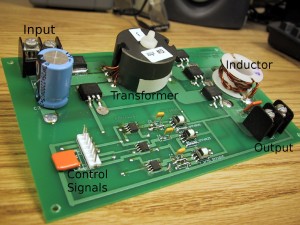Local Control of ISOP Push-pull Converters with Uneven Load Sharing
Ph. D. student Pradeep Shenoy with adviser P.T. Krein
Input series-output parallel (ISOP) converters are especially useful when stepping down the voltage in systems with a high voltage ratio. Based on the structure of the converter, the total input voltage is divided among the modules. As a result, each converter module provides a portion of the total load current needed. The push-pull topology is well suited for the ISOP approach as it provides isolation and has balanced magnetics.
This research project explores how an ISOP converter (one module shown in Figure 30) will behave when each module is locally controlled. The modules are designed to supply the load current unevenly, mostly depending on each module’s power rating. Interleaving the switching times of the modules is an important task when the modules are controlled locally instead of by a supervisory controller. Switch interleaving results in a smaller output ripple.
One goal of this project is to be able to add and remove modules from a converter without interrupting the operation. Another is to allow the modules to operate with different control algorithms and still maintain converter stability. Overall, this could help improve converter efficiency and performance. Applications of this research range from sleep modes on electronic devices to ease in expanding computer servers’ power supplies.
This research is supported by National Science Foundation grant NSF ECS 06-21643.
